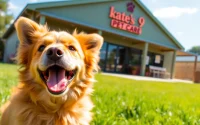Effective Strategies for Dog Training in Irvine: Build a Strong Bond with Your Canine Companion
Understanding Dog Training Basics
Dog training is an essential aspect of responsible pet ownership that not only helps in managing your dog’s behavior but also strengthens the bond between you and your furry friend. In Irvine, California, the demand for effective Dog Training Irvine services has risen significantly due to the growing population of dog owners seeking to enhance their relationships with their pets. This article delves into the fundamental elements of dog training, focusing on positive reinforcement, common behavioral problems specific to Irvine, and assessing your dog’s training needs to create a customized approach.
Importance of Positive Reinforcement
Positive reinforcement is a cornerstone of effective dog training, emphasizing the use of rewards to encourage desirable behavior. Instead of employing punitive measures, training methods based on positive reinforcement foster an environment of trust and companionship, making training a rewarding experience for both the owner and the dog.
Studies have shown that dogs trained using positive reinforcement are more likely to perform commands and display good behavior consistently. This method includes rewards such as treats, praise, playtime, or affection, which motivate dogs to repeat the desired actions. By focusing on what a dog does right rather than what they do wrong, owners can nurture a more responsive and well-adjusted pet.
Common Dog Behavior Issues in Irvine
Irvine’s unique environment presents specific challenges for dog owners. Issues such as excessive barking, leash pulling, anxiety, and aggression are notably prevalent in urban areas. These behaviors can stem from a lack of socialization, insufficient physical exercise, or even fear resulting from encounters with other animals or loud noises.
Identifying these behavioral issues early on is critical for effective training. Irvine’s dog parks, bustling neighborhoods, and the presence of diverse stimuli can exacerbate these problems if not addressed properly. Understanding these challenges prepares owners to seek suitable training methods tailored to their dog’s needs.
Assessing Your Dog’s Training Needs
Before embarking on a training journey, it’s essential to assess your dog’s individual needs. Each dog is unique, with different temperaments, past experiences, and learning capabilities. Begin by observing your dog’s behavior in various situations and identifying any patterns that may indicate specific training requirements.
You may want to answer questions such as: Is my dog fearful or aggressive towards other dogs? Does he struggle with basic commands like ‘sit’ or ‘stay’? Understanding these aspects can guide you in selecting the most appropriate training methods and exercises (e.g., socialization classes or obedience training sessions).
Finding the Right Dog Trainer in Irvine
With numerous options available, selecting the right dog trainer in Irvine can be a daunting task. Many services offer specialized programs, and it’s essential to do thorough research to find a trainer that aligns with your philosophy and your dog’s needs.
Researching Local Trainers and Programs
Begin your search by investigating local dog training facilities, pet stores, and community centers that may offer training programs. Resources like Yelp and the Better Business Bureau provide reviews and ratings to help gauge a trainer’s reputation. Experienced trainers often share insights on their websites and social media pages, showcasing their training sessions and success stories.
Additionally, consider asking fellow dog owners for recommendations. Investigating methods such as group classes, private lessons, or even board-and-train programs will give you a better idea of what works best for your dog’s personality and your schedule.
Key Qualities to Look For
Once you’ve narrowed down potential trainers, assess their qualifications and experience. Key qualities to look for include:
- Certification: A certified dog trainer demonstrates formal training and adherence to industry standards.
- Training Style: Ensure the trainer’s methodology aligns with your preferences—for example, focus on positive reinforcement versus correction-based techniques.
- Experience: Look for trainers who have successfully worked with dogs that display similar behavioral issues as your own.
- Communication Skills: A good trainer should be able to clearly articulate techniques and goals, making it easier for you to implement them at home.
Comparing Training Methods in the Area
In Irvine, various training methods are employed, from clicker training to relationship-based approaches and agility training. Each method has its strengths, and understanding these can help in making an informed decision.
For instance, agility training can provide mental and physical stimulation, beneficial for high-energy dogs. On the other hand, techniques like Behaviour Adjustment Training (BAT) help dogs learn to cope in challenging situations, particularly for those who might be fearful or reactive.
Research the pros and cons of each training method and discuss them with potential trainers to determine which aligns best with your dog’s needs.
Popular Training Techniques for Dog Owners
Once you have found the right trainer, familiarizing yourself with popular training techniques can enhance your participation and understanding in the training process.
Obedience Training Essentials
Obedience training is foundational for all dogs and typically includes basic commands like sit, stay, come, and heel. These commands not only facilitate better control of your dog but also promote safety and good manners.
Engage in regular practice sessions with your dog in a distraction-free environment, gradually introducing distractions as they master each command. Reinforcing these commands with praise and treats will foster a positive learning experience.
Socialization Skills for Your Dog
Socialization is crucial for dogs of all ages, particularly for puppies. A well-socialized dog is typically more adaptable, confident, and less likely to develop behavioral issues. In Irvine, puppies should be exposed to different environments, people, and other animals to build their social skills.
Participating in group classes or joining playdates can provide valuable social interaction. Ensure these gatherings are held in a controlled environment where dogs can safely explore and interact under guidance.
Behavioral Training for Specific Challenges
Behavioral training addresses specific challenges such as aggression, anxiety, or excessive barking. The methods used may differ based on the issue at hand. For example, counter-conditioning techniques can be effective for fear-based behaviors, while desensitization may help with anxiety.
Identifying triggers and understanding your dog’s emotions will enable you to approach behavioral training with empathy and strategic planning.
Creating a Training Plan Tailored to Your Dog
Every dog is unique, and developing a personalized training plan is vital for success. A thoughtful plan considers your dog’s specific needs, your training goals, and suitable techniques.
Setting Realistic Goals for Training Success
Establishing clear, measurable goals helps in tracking your dog’s progress and maintaining motivation throughout the training process. Consider focusing on short-term goals, such as successfully teaching a new command within a week, and medium- to long-term goals that include behavior modification or advanced obedience skills.
Goals should reflect your lifestyle as well, allowing flexibility in your training schedule for consistent practice sessions.
Incorporating Training into Daily Routines
Integrating training into daily life strengthens learning and offers additional bonding moments between you and your dog. Use everyday situations, such as mealtime, walks, and play, as training opportunities. For instance, practice “sit” before serving food or “stay” while you prepare for a walk.
This consistency reinforces commands while embedding training into your dog’s routine, making it enjoyable and engaging.
Tracking Progress and Adjusting Techniques
Monitoring your dog’s progress is crucial for maintaining effective training. Keep a journal to document achievements, challenges, and the techniques that work best. This will allow you to adjust your approach as needed, ensuring that training remains effective and responsive to your dog’s evolving needs.
Consider scheduling regular check-ins with your trainer to discuss your dog’s progress and receive feedback on methods for further improvement.
The Benefits of Ongoing Dog Training
Continuous training yields numerous benefits that extend beyond basic obedience, fostering a harmonious relationship between you and your dog.
Developing a Stronger Bond with Your Dog
Engaging in training promotes trust and communication between you and your dog. As you work together towards common goals, you enhance your bond, creating a connection built on respect and understanding. This bond fosters loyalty and makes your dog more willing to respond positively to your commands.
Paw-sitive Social Outings and Playdates
Regular training can lead to more enjoyable social outings and playdates. Well-trained dogs are generally more welcomed in public places, dog parks, and gatherings, as their behavior is more predictable and manageable. This facilitates positive interactions with other dogs and humans, fostering a social and happy pet.
Maintaining Consistent Training Standards
Ongoing training ensures that your dog retains learned behaviors and continues to develop new skills. Consistency in your training approach yields long-term benefits, enhancing not only your dog’s obedience but also their overall well-being.
Remain proactive in your training efforts and continually seek opportunities to reinforce your dog’s skills, contributing to a well-behaved, happy pet.


